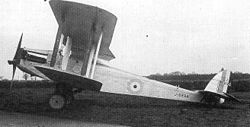De Havilland DH.27 Derby
| De Havilland DH.27 Derby | |
|---|---|

|
|
| Type: | bomber |
| Design country: | |
| Manufacturer: | |
| First flight: |
October 13, 1922 |
| Number of pieces: |
2 |
The de Havilland DH.27 Derby was a single-engine biplane produced by the British aircraft manufacturer de Havilland Aircraft Company . Only two prototypes were made.
development
The DH.27 was designed by de Havilland based on a specification by the British Department of Aviation for a heavy bomber.
The aircraft was a two-legged biplane with fabric-covered wooden wings. The fuselage was designed so that up to four bombs could be attached as an external load; up to three crew members (pilot, observer / gunner, navigator / bombardier) found space in the machine.
The DH.27 was powered by a water-cooled Rolls-Royce Condor III engine, the radiator of which was attached to the nose of the machine and which acted on a four-blade propeller.
The first of the two machines took off on its maiden flight on October 13, 1922. The Ministry of Aviation, however, decided on the rival Avro Aldershot ; this machine was lighter than the DH.27 and could carry the bomb load internally.
The two prototypes were flown on the RAF base at Martlesham Heath and the naval base on the Isle of Grain until their final decommissioning around 1924 .
Technical specifications
| Parameter | Data |
|---|---|
| length | 14.43 m |
| height | 5.13 m |
| span | 19.66 m |
| Wing area | 104.10 m² |
| drive | a Rolls-Royce Condor III engine V 12 with 485 kW (650 PS) |
| Top speed | 169 km / h |
| Range | approx. 890 km |
| Empty mass | 3056 kg |
| Max. Takeoff mass | 5237 kg |
| crew | 3 men (one pilot, one observer / gunner, one navigator / bombardier) |
| Armament; | 1 Lewis machine gun in the slewing ring, 4 × 250 kg bombs as external load |